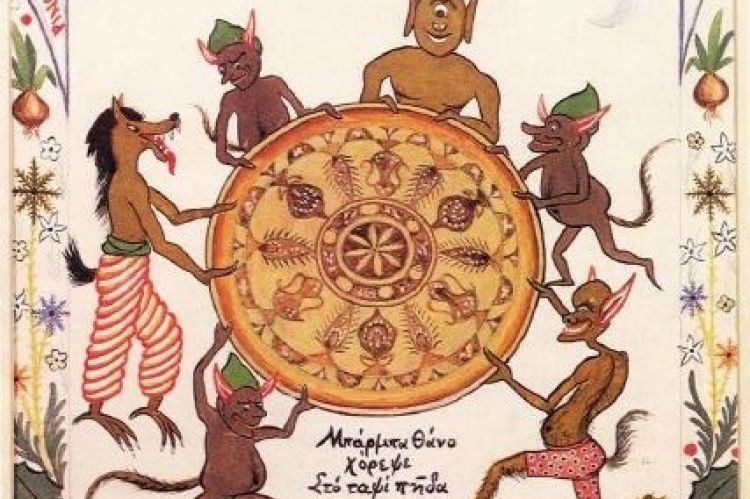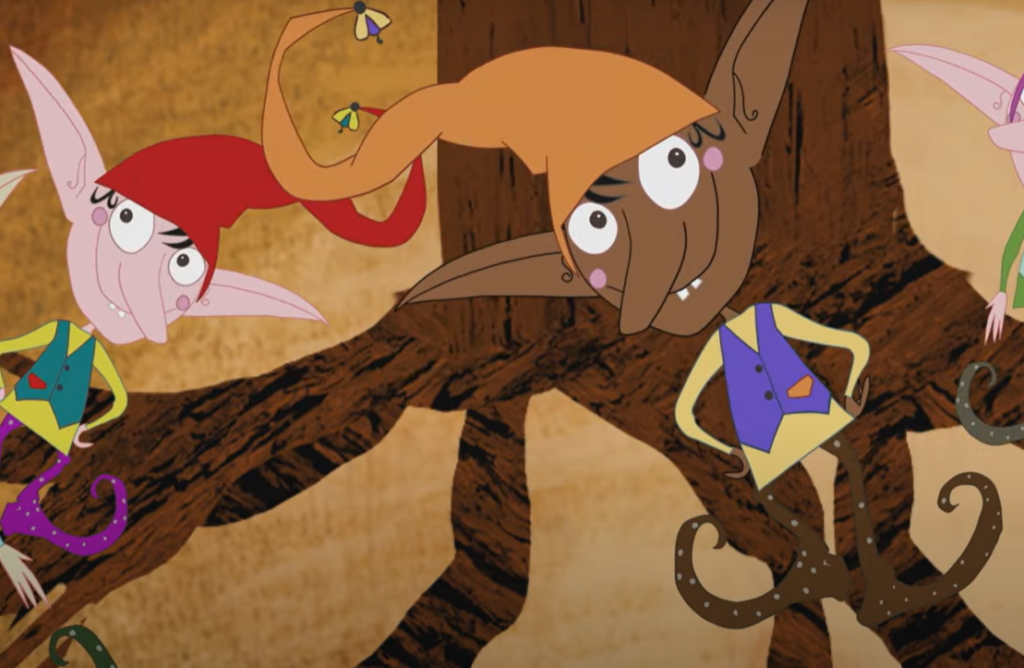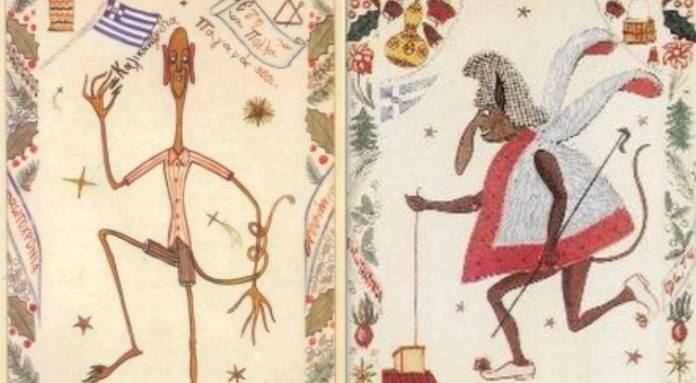Kilikantzari and their story
Who hasn’t heard of the Christmas goblins. In Greece we name them Kalikantzari (o Klaikatzaros one person). Those little monsters that come for the twelve days of Christmas and leave on the last day, at the fest of The Lights.
The beliefs are many, the stories even more and it’s interesting to see who the 18 kalikantzari are and what they symbolize.
“They come from the earth below. All year long they chop down with axes to cut down the tree that sustains the earth, but when they are about to cut it down, Christ comes and all at once the tree grows back and then the demons come to the earth above and tempt the people” Nicholas Politis
The kalikantzari are a Greek belief (of ancient origin) of “demons” who, according to modern belief, appear during the Twelve Days (December 25 – January 6).
Their leader is Mandrakoukos, who is lame and wild and the most dangerous of the whole group. He is followed by Magaras, with his huge belly, who worships all foods and sweets. Then there’s Kolovelonis, who’s skinny and pouty as a spaghetti and can get through keyholes and crevices. Another is Copsahili with huge sharp teeth hanging out of his mouth. No two are alike, and each has his own little vice.
Form – Features
The people imagine them in various forms by region with their ugliness as a common feature. According to Arachovite description these are: “ill-favoured” and “disgusting”, “each one of them has a vice, some crooked, others lame, others one-eyed, one-legged, crooked-footed, crooked-mouthed, crooked-faced, crooked-handed, all the vices and cripples of the world are found on them”.
They are usually imagined as dwarfs, but they are also tall, dark-skinned, with small and unkempt hair, red eyes, monkey teeth, shaggy, shaggy hair, monkey hands and claws, donkey feet, or one donkey and the other human, (“half donkeys and half men as they say in Syros) but also like “little devils” – (satanopiddies as they say in Naxos), sometimes naked and sometimes rags with a cap of pig’s hair and with shoes sometimes of iron and sometimes of tsarugia or tsaggia. They are very agile, climbing up trees, jumping from roof to roof, breaking tiles and making a lot of noise.
And anything they find spread out they stomp on. When they get a chance they go down chimneys into houses and they’ll chew up anything.
In some places the goblins are accompanied by their mother “Kalikatzarou” who tells them what to do. In some islands the kalikantzari come with their wives or only their wives, the “Kalikantzarines”! And in order for the housewives to avoid such a flock they throw pieces of pork or sausages or dried pork on the tiles!



Kalikantzari have names according to their properties and characteristics.
More specifically:
1) KALIKANTZAROS MALAGANA
Malaganas needs a lot of attention because he tricks children with sweet talk and thus manages to take their sweets
2) KALIKANTZAROS TRICOLOPODIS
Tricklefoot has an octopus hand that he sticks it everywhere and people poke at it. He really likes to tangle the threads from Grandma’s knitting.
3) KALIKANTZAROS PLANETAROS
The Planetary Man deludes people because he can transform himself into an animal or a tangle.
4) KALIKANTZAROS MALAPPERDA
Malapperda likes to pee and on food while it is cooking. That’s why those housewives who know him make sure they close the lid of their pot tightly.
5) KALIKANTZAROS MAGARES
The Magara has a belly like a tummy and leaves stinky gas on people’s food.
6) KALIKANTZAROS MANTRAKOUKOS
He is the leader. He hides in the pens by day and at night he comes out and teases women walking down the street. He is stubby, stumpy, stiff-legged, bald, ugly-faced, more than the others and very dangerous.
7) KALIKANTZAROS KATAHANAS
The Goblin eats constantly and everything. He leaks and stinks horribly.
8) KALIKANTZAROS PERIDROMOS
He is the other big mouth of the group.
9) KALIKANTZAROSS KOULOHERIS
He’s a slapper, with one short arm and one long arm, and he’s always getting confused and falling down.
10) KALIKANTZAROS PARORITIS
He has a nose like a proboscis and very soft one. He appears a few hours before the rooster crows, before dawn and is obsessed with taking people’s calls.
11) KALIKANTZAROS GOURLOS
He has eyes as huge as eggs and popping out. Of course he doesn’t miss anything.
12) KALIKANTZAROS KOPSOMESITIS
He is a lame hunchback and more than any other goblin, he likes honey pancakes.
13) KALIKANTZAROS STRAVOLEMIS
He is constantly spinning his head around like a spinning top.
14) KALIKANTZAROS KOPSAHILIS
His teeth are huge and hang out of his lips. He likes to make fun of priests, so he usually wears a false stocking.
15) KALIKANTZAROS KOLOVELONIS
He is as long as a spaghetti so he can easily get through keyholes and sieve holes. It is particularly quick and fast in its movements. It is said that Kolovelonis may have a tail that ends in an arrow.
16) KALIKANTZAROS VATRAKOUKOS
This froggy goblin is a huge and identical frog.
17) KALIKANTZAROS KATSIKOPODAROS (GOATFOOT)
His majesty is bald and balding and has a goat’s foot . He is scabby, miserable and unlucky. Wherever he puts his goat’s foot he brings disaster.
18) KALIKANTZAROS PAGANOS its majesty is lame. It is even said that he was kicked by the donkey of Maro, a peasant girl who was once chased by Paganos to make her his wife, but she hid in the sacks of flour loaded on her donkey and managed to escape him. Paganos ran frantically near the donkey and searched for her. The animal was then so frightened that it started kicking. A strong one seemed to have been eaten by Paganos and he was crippled.
Paganos loves ashes and that’s why he sneaks in through the chimneys. But he fears fire more than all the Kalikandjars, so the landlords make sure it doesn’t go out during the twelve days. They even throw salt, which makes a noise when it falls on the fire, to scare him even more.
The… trolls
Forms like the kalikantzari exist in almost all the nations of the world. Most famous are the Norwegian trolls. Trolls are frightening creatures of Norse mythology that are often described as man-eaters. In recent years the term troll has been used for internet users who, like goblins, enter a topic, a discussion, an opinion in order to destroy it by insulting the author in every way possible.
In recent years the tradition, or if you like the myth of the kalikantzari, has slowly started to fade away. On the altar of commercialization of values and traditions, the goblins were simply the weak link, and as a result, modern society displaced them. They may not bring gifts, they may not prepare requiems, but they are what remains of the pure tradition of our land…
https://www.in.gr/2021/01/06/stories/kalikantzaroi-ola-osa-prepei-na-gnorizete-gia-ta-teratakia-ton-xristougennon/
